SCI begins a massive rebuild of its Paducah, Ky. simulators used to train mariners for safety on the water.
The Seamen’s Church Institute (SCI) has signed a contract with Kongsberg Maritime for a complete overhaul of important maritime simulator technology at its Center for Maritime Education campus in Paducah, Ky. Installation begins in August to replace existing wheelhouse architecture with entirely new mechanisms and navigation tools that more closely mirror contemporary equipment and construction of modern vessels.
The new simulators strengthen SCI’s service to American mariners. “We have spent the last year gathering input from professional mariners and researching next-generation simulation technology,” says Captain Stephen Polk, Director of Maritime Education & Training at SCI. “The renovation of SCI’s equipment provides mariners with the tools they’ve requested and sets the stage for SCI to deliver the best possible training for years to come.”
Technology employed in the new simulators provides capacity for nighttime scenes on over 20 newly modeled vessels. All wheelhouses employ traditional steering levers, conventional throttles, and emerging z-drive azimuth thruster systems.
Phase 1 construction is scheduled for completion in November 2014.
Grant helps MMA pay for simulator system
Grant helps MMA pay for simulator system, refuel training ship
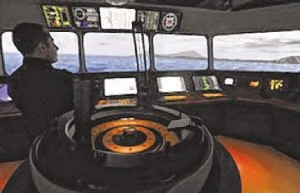
BUZZARDS BAY “” With a $1 million grant from the sale of obsolete vessels in the National Defense Reserve Fleet, Massachusetts Maritime Academy plans to upgrade its simulation system and chip into its training ship’s refueling bill.
The academy, like each of the nation’s five other state maritime schools and the U.S. Merchant Marine Academy in Kings Point, N.Y., was awarded the grant Thursday from the U.S. Department of Transportation. Under the National Maritime Heritage Act, the department’s Maritime Administration is required to devote 25 percent of profits from the vessel sales to the academies for “facility and training ship maintenance, repair and modernization, and for the purchase of simulators and fuel.”
The law was passed in 1994, but Adm. Richard Gurnon said the academy never anticipates the funding, which depends upon the federal government culling obsolete ships and selling them to be scrapped and recycled.
The most recent grants have come in two-year increments to the Taylors Point campus, with about $700,000 in funding in 2012 and $500,000 in 2010, Gurnon said.
“We don’t expect any of it, because it is quite random,” said Gurnon, president of the Buzzards Bay academy. “It’s always money from heaven.”
Gurnon plans to spend $250,000 in grant funding to upgrade the academy’s “360 simulator” “” a windowless room inside the recently constructed library where 15 projectors create a moving panorama of currents, sea gulls and other ships coming into harbor. But the system, which Gurnon likens to a fancy XBox 360, is not currently equipped to train students in dynamic positioning “” an autopilot technology that accounts for waves and currents to keep drilling ships and supply boats perfectly in place.
SCI Simulator Offers One-on-one Training
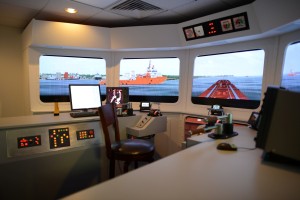
What does a new year of training look like at SCI? With a new simulator in full operation, SCI helps individual mariners complete assessments previously only available in large class settings or in the real world when exact conditions could be met on the water.
The Seamen’s Church Institute’s (SCI) Center for Maritime Education puts mariners in real-life situations using high-tech simulation equipment. Most days, SCI classrooms host groups of six to eight students as part of training sessions sponsored by maritime transportation companies; however, thanks to a new simulator bridge installed at SCI’s Houston Center last fall, mariners do not have to come to SCI as part of a group or business to train or undergo assessments on tasks needed to maintain license certification. The new simulator offers affordable one-on-one assessments to help mariners meet their individualized training goals.
SCI’s new simulator allows mariners to obtain credentials for licenses, including the Towing Officer Assessment Record (TOAR) and radar recertification. It also helps mariners applying for new jobs and assignments, allowing them to demonstrate their skills to the company. Programmable simulations also let candidates demonstrate their ability to handle new challenges and geographic locations.
Recently, SCI helped one such mariner advance his career with the newly installed simulator. The mariner needed to complete a TOAR, an often difficult-to-arrange assessment requiring a skills appraisal in a specific geographic location. In this case, the mariner had worked on the waters for two years and had received good preparation from his captain, but his experience had not yet required him to navigate through a lock system.
SCI’s instructors and a designated examiner (DE) set up an exercise that would teach the mariner the needed skills. Then, they tested his knowledge and competency on the simulator navigating through a model of a real lock on the river. They arranged several one-hour sessions with varying degrees of involvement from the DE. During the final run, the DE exited the simulator and sat in the observation room. With three sessions on the simulator, the mariner passed the assessment, receiving signoffs on five mandatory TOAR maneuvering procedures.
On review of the process, the DE commented that the student learned very quickly. If he made a mistake on the first run, the examiner noted, he corrected it in the subsequent trial. By the third run, the mariner had acquired the skills necessary to complete the maneuvers without any help from the DE. The simulator provided a familiar environment””so realistic that the mariner could apply his experience on the water””to learn new skills quickly and easily.
In 2014, SCI harnesses the power of this technology to help more professionals in the maritime industry. Because of the Transas simulator’s extreme adaptability, additional uses include instruction for mooring masters, the development of feasibility studies and, with the flip of a switch, nighttime simulations.
KIMFT purchases NAUTIS FMB simulators and desktop classroom
(vstep.nl)
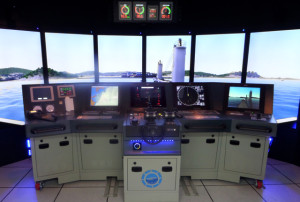
A NAUTIS Desktop Trainer classroom and two class A NAUTIS FMB simulators were purchased by the Korea Institute of Maritime and Fisheries Technology (KIMFT) in Busan, South Korea. All simulators are part of the upgraded maritime simulator training wing at the Busan Campus.
The KIMFT was formed in 1998 from the merger of the Korea Fishing Training Center with the Korea Maritime Training and Research Institute and is one of the leading Maritime Universities in South Korea.

The KIMFT purchase includes two NAUTIS Class A Full Mission Bridge Simulators and instructor station, as well as a classroom of 12 NAUTIS Desktop ECDIS/Navigation Trainers. NAUTIS is a new generation of DNV certified maritime simulators developed by VSTEP. The simulators were delivered and installed at the KIMFT premises by NAUTIS developer VSTEP and its Korean partner SamWooSoft Co., Ltd. The simulators provide students at the university with the latest in advanced DNV certified maritime simulation technology.
Dae-Hee Kim, SamWooSoft CEO: “We are very happy with the NAUTIS simulators provided by VSTEP. The open architecture of NAUTIS allowed us to develop many customizations that were requested by the client in a limited amount of time. The bridge lay-out was changed during the implementation a number of times on client request, and we added several touch display panels with nautical instruments for which we developed the software locally. For the project, a series of 3D models of Korean ports were developed by the VSTEP and Samwoosoft 3D modelers in a short time frame, with a high level of quality.”
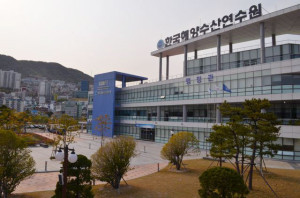
The FMB simulators are equipped with an additional NAUTIS Tug module, allowing realistic tug training in addition to the DNV certified STCW criteria training. The FMB simulators were installed with an innovative system whereby a conventional ship bridge is combined with a tug bridge, on wheels. Using guiding rails, the combined console can be rolled forward for the conventional bridge training, and backwards for the tug training. This set-up provides a wide range of training options in a very cost- and space-effective way.
The NAUTIS Desktop Trainers are high quality portable simulators that allow training of many competencies, including ECDIS Model Course 1.27, and basic ship handling & maneuvering.
For more information about NAUTIS Maritime Simulators by VSTEP, visit www.nautissim.com
For more information about the KIMFT, visit www.seaman.or.kr
Resolve Maritime Academy Opens Engine Room Simulator
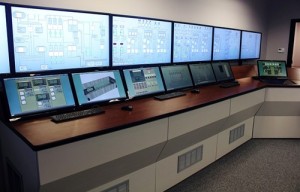
Resolve Maritime Academy recently completed its installation of Transas engine room simulator platform, the ERS 5000 TechSim. As part of the Academy’s Simulation Training Center in Fort Lauderdale, Florida, the engine room has booked classes for January 2014.
The ERS 5000 TechSim has allowed Resolve Maritime Academy to expand its course offerings to engineers from all sectors of the maritime industry including the offshore, tanker and cruise sectors.
The engine room simulator is connected to Resolve Maritime Academy’s full mission bridge simulator, allowing integrated training options for a variety of courses. “Connecting the simulators means we can offer Resource Management and Integrated Systems training to our clients,” said David Boldt, Simulation Training Group Manager at Resolve Maritime Academy.
Resolve Maritime Academy hired Rosemary Mackay, an engineer with nine years of experience in maritime education (and 12 years of at-sea experience) to manage the ERS 5000 TechSim. Mackay joins the Academy from Star Center, where she instructed classes offered at the Star Center Engineering Department and was directly involved in course design and development.
The Transas ERS meets STCW code requirements. The scope of training objectives corresponds to specifications of standard competence for engine department personnel, which provide for the use of simulators for training engineers as well as engineering instruction for operational, management and support personnel.
Kongsberg’s New DP Simulator DNV Certified

Kongsberg Maritime informs that its latest version of K-Sim DP, a Dynamic Positioning (DP) Manoeuvring simulator, has received Class A Certification from Det Norske Veritas (DNV). This makes it compliant with the highest DNV standard for DP simulators according to Standard of Certification of Maritime Simulators number 2.14 (January 2011).
The manufacturers explain that the K-Sim DP Manoeuvring is the most advanced in a long line of Dynamic Positioning simulators developed by Kongsberg Maritime. It is built on the same advanced technology platform as the market leading K-Sim Offshore (previously known as the Kongsberg Offshore Vessel Simulator) and has the power to provide realistic and relevant DP training in various simulated conditions and environments.
“The DNV Class A approved K-Sim DP is developed to conduct more operational and scenario based courses, fulfilling the industry’s training requirements and has the possibility to replace a significant amount of the on board training required in a typical Dynamic Positioning Operator (DPO) training scheme,” comments Geir Lilje, Product Advisor, Kongsberg Maritime.
The new K-Sim DP Manoeuvring simulator is configured with a dual redundant DP system and a 240 degree or wider visual scene. It includes a fully integrated Power Management System and is delivered with standard DP reference systems such as Artemis, Hydroacoustic Position Reference system (HPR), DPS and DARPS. FanBeam and RADius position reference systems are also available as options.
K-Sim DP includes an extensive Instructor system, which has the power to design realistic scenarios and introduce faults and alarm settings throughout the entire training exercise. Recording and replay of all simulation exercises in addition to objective assessment, allow the students to build competence and to be prepared for both daily and emergency situations that might occur in real life.
Transas Develops Simulators for Korea Coast Guard
Transas Marine, in collaboration with local agent Mecys, announced the completion of a complex simulator project for the Korea Coast Guard Academy (KCGA). The real hardware integration and achieved level of realism make this simulator complex truly unique. Within the project, Transas has developed models for bridge and engine room simulators matching the layout of PV3000 and three other Korea Coast Guard vessels.
The installed simulators include the Transas full mission engine room simulator ERS 5000 which is a replica of the PV3000 KCG vessel, four very specific full mission bridge simulators based on the Transas Navi-Trainer Professional 5000 (NTPRO 5000) software imitating KCG boats, a gun fire full mission simulator integrated with 3,000t vessel’s full mission bridge. Ten real KCG surveillance radars are stimulated by Transas NTPRO 5000 software. A full mission VTS simulator with six operator workplaces and an oil spill combat lab with 10 operator workplaces can operate in the common environment with the full mission bridge simulator NTPRO 5000. This functionality provides training in oil spill response for all involved parties. A navigational lab with 30 part mission NTPRO bridges with one visual channel each, conning, radar and ECDIS stations will enable practicing various scenarios for KCGA cadets. ERS lab with 30 workplaces will be used for the training of engineers.
One of the project challenges was integration of a software control of the real MTU hardware system RCS-5 with the NTPRO 5000 and ERS 5000 software in order to provide bridge, engine and joint modes of operation to enable crew resource management exercises. Real high voltage ship born Automatic Circuit Breakers (ACB) units from Terasaki with fully functional trip device module were integrated as well. ACBs automatically pick up exercise state and operate very similar to real life.
The brand-new Korea Coast Guard Academy facilities including various administrative constructions covering a huge area near the city of Yeosu will open the doors to the first groups of cadets early next year. The newly acquired simulation complex will become a valuable national asset and contribute to proficiency of maritime education and further cost savings in training of KCG officers.
The Korea Coast Guard is responsible for maritime safety and control off the coast of South Korea. The KCG is an external branch of the Ministry of Maritime Affairs and Fisheries at peacetime. The KCG has its headquarters in Songdodong, Incheon, and has hundreds of smaller operating stations along the coastline of the Korean Peninsula. The Korean Coast Guard operates four classes of heavy vessels (over 1,000 tons), three classes of medium vessels (over 250 tons), and three classes of light vessels (speedboats over 30 tons). The KCG also uses several types of ‘special purpose watercraft’, such as firefighting vessels, barges, high-speed scout boats, light patrols, and amphibious hovercraft.
Nautis OSV Simulator Delivered to Miclyn
Miclyn Express Offshore Singapore purchased a Nautis Offshore Supply Vessel Simulator and Instructor Station for training of OSV activities within the Miclyn fleet. The simulator was delivered and installed by VSTEP. Miclyn Express Offshore has followed up this initial purchase with an order for an identical simulator destined for their Joint Venture Thailand Training Facility.
The simulator deal for Miclyn Express Offshore (MEO) includes a 240-degree Nautis OSV Desktop Trainer and Nautis instructor station. The simulator will be used for realistic high quality training of OSV activities and navigation with the different vessels of the MEO fleet. For that purpose, specific MEO Offshore Supply Vessels have been added to the simulator for training.
The Nautis OSV Desktop Trainer features an innovative high performance concept whereby a full 240-degrees horizontal outside field of view is presented to the trainee. This field of view is normally only provided in bigger and more expensive Full Mission Bridge Simulators. The Nautis OSV Desktop Trainer however, manages this high performance field of view display using just one high-spec off-the-shelf PC without any framerate or quality loss.
This large field of view is needed for maneuvers whereby the OSV approaches an oil rig alongside, in which case the trainee needs to have a good view looking portside or starboard side. Conventional current desktop trainers provide a much more limited view of 30-120 degrees, which is only useful for straight reverse platform approaches. The azimuth controls for the NAUTIS OSV Desktop Trainer are provided in a desktop size control box, connected to the PC with a simple USB cable. The whole Nautis Desktop Trainer set-up is compact, fitting in any office environment.
Star Center Upgrades Bridge Simulator
Getting Real: Star Center Upgrades Bridge Simulator
Maritime training specialists, STAR Center, upgrades its bridge simulator for an unparalleled 360 degree training experience.
Digital Projection International (DPI), an Emmy® Award-winning manufacturer of high-performance projection systems, Scalable Display Technologies, a leading provider of software for automatic edge-blending, and Electric Picture, a leading systems integrator recently collaborated on a significant system upgrade to STAR Center’s maritime training simulator in Dania Beach, FL. This upgrade resulted in increased imagery resolution and vertical coverage, improved color management and made overall system maintenance more efficient.In operation since 1993, STAR Center (Simulation, Training, Assessment & Research) says it is regarded internationally as a top destination for ocean-going and inland professional maritime training and research. A division of the AMO Safety and Education Plan, STAR Center is the primary training provider for the U.S. merchant marine officers represented by American Maritime Officers. “The upgrade was a resounding success,” commented Brian Long, director of STAR Center. “The existing projectors were replaced by nine of DPI’s higher-resolution HIGHlite WUXGA 660 projectors with built-in advanced warp and blend capability, courtesy of their internal Fusion software. With the ability to run in both single and dual-lamp mode, the HIGHlite displays allow the STAR Center to accentuate extreme brightness or increased lamp efficiency based on the configuration. Additionally, the HIGHlite displays came with 3-year factory warranties.
A further benefit resulting from the projector upgrade allowed Electric Picture to increase the simulator’s vertical field of view, which, as Long noted, was “a very big deal indeed. The extra projected height reinforces that feeling of depth and full immersion and gives the simulator a much more realistic feel. The experience is very similar to being on an actual ship.” Long and the entire STAR Center team take their training responsibility very seriously. “Our central goal at STAR Center is to help produce the most well-trained, prepared maritime officers in the world. The newly upgraded bridge simulator will help us achieve that goal for years to come.” “¨
CMI Orders VSTEP Simulators
The Caribbean Maritime Institute has ordered multiple VSTEP simulators for its new high tech simulation center at the campus in Kingston, Jamaica.
VSTEP will deliver all simulator solutions for the facility, including a NAUTIS Full Mission Bridge Simulator and a Class C Engine Room Simulator. CMI also ordered full classroom setups for both NAUTIS Desktop Trainers and NAUTIS Engine Room Desktop Trainers.The new simulation center of Caribbean Maritime Institute (CMI) will serve as one of the most innovative hubs for maritime training and education in the Caribbean region, and will provide high quality training of maritime students and professionals alike in ship-handling, collision avoidance, Engine Room procedures and operations, as well as ECDIS, Radar/ARPA, AIS and other navigational aids.
After a thorough evaluation of the available maritime simulator solutions in the market, CMI selected VSTEP’s NAUTIS maritime simulators because of their high-quality, cost-effectiveness and compliance to the latest IMO STCW regulations.
The NAUTIS simulators for the CMI center include a NAUTIS Full Mission Bridge simulator and Class C Engine Room simulator. Included in the order are NAUTIS classroom setups for Engine Room Training which include multiple Engine Room desktop stations, and an additional classroom of NAUTIS Part Task Desktop Trainers, maximizing training accessibility and effectiveness at the facility. The facility will also include additional VSTEP RescueSim virtual incident management simulators for realistic training of maritime incidents.
Fritz Pinnock, Director of the CMI: “We are very pleased with our engagement of VSTEP because the purchase of these simulators will solidify our position as the simulator centre of the Caribbean. It will also make CMI the simulator showroom for VSTEP in the Americas.
Mark Polderman, Sales Director VSTEP: “We are proud to have the Caribbean Maritime Institute join the VSTEP family. With this investment, the CMI underlines its ambition to become the pinnacle of maritime training centers in the Caribbean, incorporating professional simulator training of the highest quality into its curriculum.